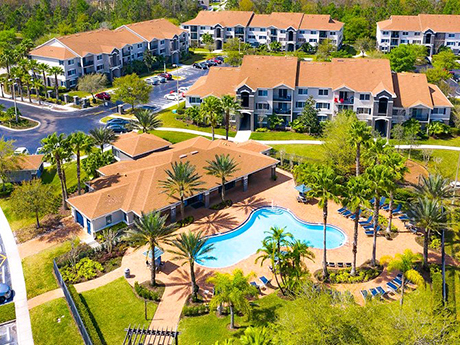Orlando remains one of the strongest multifamily markets nationally despite the slowdown being experienced in commercial real estate at large. Its strength is largely defined by growth in rent, supply, upcoming development opportunities, employment and the local economy, which have all contributed to healthy fundamentals.
Being a top U.S. tourism destination has also helped with more than 74 million visitors coming to Orlando in 2022. Local tourism has created 212,000 jobs as of year-end 2021, and the city is home to nine world-renowned theme parks that are frequented by tourists.

Orlando has also proven to be a very attractive and viable place to live long-term. The city is the fourth-largest in Florida, with an estimated population of more than 312,200 in 2023 and over 2 million within the metropolitan statistical area (MSA). The area’s population growth has supported multifamily growth opportunities, ensuring there is a vast renter pool and demand for the inventory that continues to be delivered.
That has propelled rent growth up with submarkets like Colonial Town and Florida Center North, which are still posting year-over-year increases between 10 and 16 percent, significantly higher than the national average.
Overall supply has also held up well with 6,103 units added year-to-date and 24,697 more units being built currently. The city’s largest developers are The NRP Group and D.R. Horton, which have 1,004 and 995 units under construction, respectively. NRP’s most notable projects in the area include Afton Palms, a 352-unit development at 1150 Upsala Road, and Serenza, a 320-unit development at 101 Allure Point.
D.R. Horton recently announced plans for a mixed-use project called NonaWest that will include 396 apartments, 188 townhomes and 7.8 acres of commercial property. The project will sit on a 114-acre site that the developer purchased recently near Lake Nona and Orlando International Airport.

Developers have been drawn to the Orlando metro area’s expansion and proximity to transportation and job centers. They are bullish on new multifamily projects performing well in the market as a result.
It’s expected that only 7.2 percent of the overall market supply will come on line in the next 12 months. However, occupancy and rental rates are projected to stay stable and comfortably absorb new supply as it arrives. In the meantime, the market’s existing supply has remained relatively stable despite a slower performing economy with Orlando’s market average apartment occupancy sitting at 91.2 percent.
Much of this has to do with the city’s in-migration, along with the rise in interest rates that is negatively impacting homeownership but benefiting multifamily as many individuals consider renting as a more cost-effective solution. This has not only attracted developers, but the appetite from investors is strong because of the recession-resistent fundamentals and future job creation in the area.
There have been 19 investment sales completed in 2023 so far worth $815 million in volume. Total deal activity in 2023 will likely be down compared to what we saw in 2022, but it’s evident that properties are still trading, and the activity seen so far indicates the resilience of Orlando’s multifamily market.
Another driver of Orlando’s multifamily growth has been the market’s positive employment and overall economy. The Orlando-Kissimmee-Sanford metro area comprises Lake, Orange, Osceola and Seminole counties. The MSA boasts an impressive 2.7 percent unemployment rate and has numerous tourist attractions, such as Walt Disney World, Universal Orlando Resort and Sea World, and is home to professional sports teams the Orlando Magic and the Orlando City Soccer Club. Orlando also has reputable higher education institutions such as the University of Central Florida, the nation’s second-largest university.
Not to mention, Orlando is a central location for visitors and for the movement of goods throughout the Sun Belt via the Orlando International Airport, Port Canaveral and I-4. These have been economic drivers for Orlando’s economy for years, and more recently, the highest job growth has been in the leisure and hospitality, education and healthcare sectors. Orlando’s dynamic economy has created a significant need for a variety of employment types and available housing options to support the market’s 908,000-plus and growing workforce.
While it’s not completely clear what the multifamily market will look like at the end of 2023, one thing we know for certain is that Orlando is continuing to grow and perform well across key multifamily and economic performance indicators. This signals that the market is well-positioned to maintain steady movement throughout the remainder of the year.
— By Nick Meoli, Vice Chairman, and Mike Donaldson, Vice Chairman of Cushman & Wakefield. This article was originally published in the August 2023 issue of Southeast Real Estate Business.


